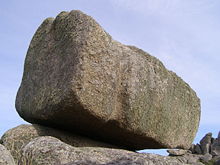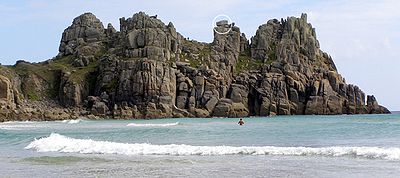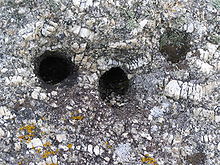
Logan Rock
Encyclopedia

Cornwall
Cornwall is a unitary authority and ceremonial county of England, within the United Kingdom. It is bordered to the north and west by the Celtic Sea, to the south by the English Channel, and to the east by the county of Devon, over the River Tamar. Cornwall has a population of , and covers an area of...
, England, UK, is an example of a logan or rocking stone
Rocking stone
Rocking stones are large stones that are so finely balanced that the application of just a small force causes them to rock. They are found throughout the world. Some are man-made megaliths, but others are natural, often left by glaciers.Logan or rocking stones are known in Scotland sometimes as...
. Although it weighs some 80 tons, it was dislodged in 1824 by a group of British seamen, intent on showing what the Navy could do. However following complaints from local residents for whom the rock had become a tourist attraction and source of income, the seamen were forced to restore it.
Today the Logan Rock still rocks, but with much less ease than it did in the past.
Description
The rock is an eighty ton granite boulder perched on the edge of the cliffs overlooking the Atlantic OceanAtlantic Ocean
The Atlantic Ocean is the second-largest of the world's oceanic divisions. With a total area of about , it covers approximately 20% of the Earth's surface and about 26% of its water surface area...
, on a headland one mile south of the village. The rock is finely balanced due to the actions of weathering, and prior to its restoration in 1824 it could be rocked by applying only a little pressure.
As well as the logan stone itself, the name Logan Rock is also applied to the surrounding tip of the headland. Cripp's Cove
Cripp's Cove
Cripp's Cove is a cove on the coast of west Cornwall, United Kingdom.The inlet is situated on the Logan Rock peninsula one mile west of Porthcurno. The tiny island of Seghy stands a few metres off Cripp's Cove....
lies to the east beneath the rock. The headland is also an Iron Age
Iron Age
The Iron Age is the archaeological period generally occurring after the Bronze Age, marked by the prevalent use of iron. The early period of the age is characterized by the widespread use of iron or steel. The adoption of such material coincided with other changes in society, including differing...
promontory fort
Promontory fort
A promontory fort is a defensive structure located above a steep cliff, often only connected to the mainland by a small neck of land, thus utilizing the topography to reduce the ramparts needed. Although their dating is problematic, most seem to date to the Iron Age...
called Treryn Dinas, defended by three ramparts. A number of islands are located around the edge of Logan Rock including Great Goular, Horrace, and Seghy
Seghy (Island)
Seghy is a tiny island off the coast of west Cornwall, United Kingdom. It is the largest rock in Cripp's Cove, an inlet on the Logan Rock peninsula one mile west of Porthcurno. Its name, pronounced "sai-hee", is properly 'seghys', Cornish for 'drying', the rock is usually seen with shags and...
.
Name
The word "logan" (properly pronounced "logg-un") is probably derived from the word "log", which in an English dialect means "to rock". In fact, in some parts of the UK, rocking stones or logan stones are called logging stones. The word "log" might be connected with the Danish word "logre", which means to "wag a tail".Some have suggested that it comes from a Cornish expression for the movement that someone makes when drunk. Davies Gilbert
Davies Gilbert
Davies Gilbert FRS was a British engineer, author, and politician. He was elected to the Royal Society on 17 November 1791 and served as President of the Royal Society from 1827 to 1830....
writes:
- It may be observed that I have always used the words Loging Rock for the celebrated stone at Trereen Dinas. Much learned research seems to have been idly expended on the supposed name, "Logan Rock." To log is a verb in general use throughout Cornwall for vibrating or rolling like a drunken man; and an is frequently heard in provincial pronunciation for tug, characteristic of the modem present participle. The Loging Rock is, therefore, strictly descriptive of its peculiar motion.
It should also be noted that the name for rocking stones could be a modified form of the Danish word "logre," which means 'to wag the tail,' and this suggests possible Norse origin. Danes in particular established a kingdom in Great Britain before 1000 A.D., Norway maintained nominal control over the Hebrides in northern Scotland until the late Middle Ages, and Vikings frequently raided along the British coastal areas between 800 and 100 A.D. Thus, a Norse origin for the word Logan, while speculative, cannot be ruled out.
Story of the rock

Rocking stone
Rocking stones are large stones that are so finely balanced that the application of just a small force causes them to rock. They are found throughout the world. Some are man-made megaliths, but others are natural, often left by glaciers.Logan or rocking stones are known in Scotland sometimes as...
s for several reasons. For example, Modred, in William Mason
William Mason (poet)
William Mason was an English poet, editor and gardener.He was born in Hull and educated at Hull Grammar School and St John's College, Cambridge. He was ordained in 1754 and held a number of posts in the church....
's dramatic poem "Caractacus," addressing the characters Vellinus and Elidurus, says of the Logan Rock:
-
-
- Thither, youths,
- Turn your astonish'd eyes; behold yon huge
- And unhewn sphere of living adamant,
- Which, poised by magic, rests its central weight
- On yonder pointed rock: firm as it seems,
- Such is the strange and virtuous property,
- It moves obsequious to the gentlest touch
- Of him whose breast is pure; but to a traitor,
- Tho’ ev’n a giant’s prowess nerv’d his arm,
- It stands as fixt as Snowdon.
-

Oliver Goldsmith
Oliver Goldsmith was an Irish writer, poet and physician known for his novel The Vicar of Wakefield , his pastoral poem The Deserted Village , and his plays The Good-Natur'd Man and She Stoops to Conquer...
), and ten or twelve of his crew of the cutter HMS Nimble, armed with bars and levers rocked the huge granite boulder until it fell from its cliff-top perch. Goldsmith was apparently motivated to disprove the claim of Dr Borlase
William Borlase
William Borlase , Cornish antiquary, geologist and naturalist, was born at Pendeen in Cornwall, of an ancient family . From 1722 he was Rector of Ludgvan and died there in 1772.-Life and works:...
, who wrote in Antiquities of Cornwall in 1754 that:
- In the parish of S. Levan, there is a promontory called Castle Treryn. This cape consists of three distinct groups of rocks. On the western side of the middle group near the top, lies a very large stone, so evenly, poised that any hand may move it to and fro; but the extremities of its base are at such a distance from each other, and so well secured by their nearness to the stone which it stretches itself upon, that it is morally impossible that any lever, or indeed force, however applied in a mechanical way, can remove it from its present situation.

This upset the local residents considerably, since Logan Rock had been used to draw tourists to the area. Treen had become a lucrative tourist destination. Sir Richard R. Vyvyan was particularly unhappy. The local residents demanded that the British Admiralty strip Lieutenant Goldsmith of his Royal Navy commission unless he restored the boulder to its previous position at his own expense.
However, Davies Gilbert
Davies Gilbert
Davies Gilbert FRS was a British engineer, author, and politician. He was elected to the Royal Society on 17 November 1791 and served as President of the Royal Society from 1827 to 1830....
persuaded the Lords of the Admiralty to lend Lieutenant Goldsmith the required apparatus for replacing the Logan Rock. The Admiralty sent thirteen capstans with blocks and chains from the dock yard at Plymouth
Plymouth
Plymouth is a city and unitary authority area on the coast of Devon, England, about south-west of London. It is built between the mouths of the rivers Plym to the east and Tamar to the west, where they join Plymouth Sound...
, and contributed £25 towards expenses. Gilbert also raised more funds

For some time after, the rock was kept chained and padlocked, but eventually these restrictions were removed, and the rock was set free. Tourism declined and this was blamed on the condition of Logan Rock. For a while, Treen was nicknamed 'Goldsmith's Deserted Village'. The anchor holes used to haul the huge rock back into place are still visible in the surrounding rocks. However, it apparently no longer vibrates or "logs" as easily as it did before. Francis Kilvert
Francis Kilvert
Robert Francis Kilvert , always known as Francis, or Frank, was born at The Rectory, Hardenhuish Lane, near Chippenham, Wiltshire, to the Rev. Robert Kilvert, Rector of Langley Burrell, Wiltshire, and Thermuthis, daughter of Walter Coleman and Thermuthis Ashe...
on his visit on 27th July 1870:
At the foot of the steep rock on which the Logan Stone is balanced a man stood ready to show the way up, and when he saw me coming he began to run up just like a monkey. His action was so sudden, strange and wild, and so exactly that of a monkey clambering up the bars of his cage, that I looked to see whether he had a tail. He helped me up capitally with knee and hand. I could never have got up by myself for the rock faces were very steep, smooth and slippery. ..... The guide first put his shoulder under the Stone and rocked it, and then I did the same. It rocks perceptibly, though very slightly. But is has never rocked so well and easily since it was wilfully thrown down.
Nonetheless, local historian Craig Weatherhill
Craig Weatherhill
Craig Weatherhill is a Cornish author both of fiction and non-fiction works about Cornwall.-Biography:Raised in St Just in Penwith and then in Falmouth, after serving in the forces he developed a career in conservation and architecture. In his younger days, the 6' 3" Weatherhill was a goalkeeper,...
asserts that a series of rhythmic heaves against the south-western corner of the rock will set it moving, after which, the motion can be kept going with the efforts of one hand. He also mentions another smaller logan on the headland, the Lady Logan Rock, which legend tells is a giantess petrified by curses from the dying husband she had just murdered. Tourism declined and this was blamed on the condition of Logan Rock and for a while, Treen was nicknamed 'Goldsmith's Deserted Village'. The anchor holes used to haul the huge rock back into place are still visible in the surrounding rocks.

